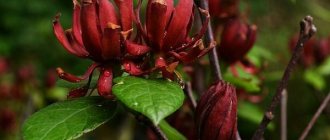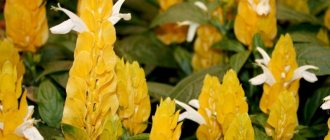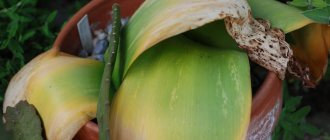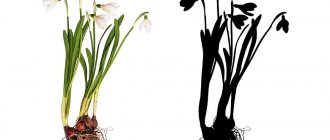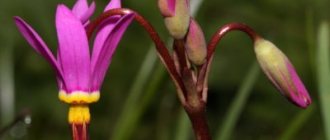Plant morphology
Agapanthus is a perennial herbaceous plant, up to 70 cm high. Even without flowers, agapanthus attracts attention with the decorative appearance of its dense rosette, which consists of belt-shaped, smooth, dark green leaves tapering towards the end. In mid-summer, slender, round, naked flower arrows appear from it, ending in large umbrella-shaped inflorescences. The inflorescence contains up to 150 bell-shaped flowers. The perianth consists of 6 petals fused at the base. The petals are blue, white and cream.
Agapanthus blooms from mid-summer to late autumn. After pollination of the flower, within one month, the seed box matures.
On a note!!!
Although agapanthus is a relative of the onion, it does not have a specific pungent odor, and its rhizome does not at all resemble an onion.
Agapanthus
In cultivation, the most common is A. umbellatus with ribbon-shaped grooved leaves and beautiful blue flowers located in an umbellate inflorescence at the top of a long peduncle.
The plant is most often grown in open ground, although there are growers who keep agapanthus at home.
Description and characteristics of agapanthus
The life span of agapanthus is quite long; in most varieties it is evergreen, has an elongated peduncle and leaves of an exotic shape, which are somewhat reminiscent of the leaves of yellow daylily, which has long been widely used for decorative purposes.
The plant has a characteristic, rather fleshy, short root and thick stem (the flower reaches a height of one and a half meters). Flowering time is long, up to 2 months.
About 30 funnel-shaped flowers are collected in inflorescences (diameter - 30-45 mm) in the shape of an umbrella of delicate colors - from blue-lilac to milky white, have 6 petals, stamens with brown pollen. Peak flowering occurs in July and ends at the end of August. Agapanthus grow in large groups; being native to Africa, they tolerate hot climates well, but cold below (+10 °C) is destructive for them.
Agapanthus: lighting
Agapanthus loves well-lit places, reliably protected from the winds. Although the flower does not suffer much from drafts and usually tolerates them well. With a lack of light, the flower stalks begin to lengthen, which spoils the appearance of the plant and the flower may need supports.
The best options for agapanthus are windows located on the south, southeast and southwest sides.
On a note!!!
Lack of light negatively affects agapanthus. The flower stops blooming. Loses its beauty.
Caring for agapanthus at home
Illumination
For indoor agapanthus, you should choose a sunny place. If there is not enough light, the peduncle will grow very long and thin, and it will need additional support. The flower develops best on a windowsill with south-west, south-east and south orientation.
Temperature
Experienced gardeners recommend keeping agapanthus in the garden or on the balcony in spring and summer, when it is warm outside. For the winter, the bush is transferred to a well-lit and cool (no warmer than 12 degrees) room.
How to water
In spring and summer, such a plant should be watered regularly and abundantly. With the beginning of September, a gradual reduction in watering is carried out, and in winter they water rarely and with a small amount of water, while not allowing the earthen clod to dry out. Also, at any time of the year, make sure that the liquid does not stagnate in the roots of the plant.
Air humidity
This flower does not need additional spraying because it grows and develops normally even at low air humidity.
Fertilizer
From the second half of spring until the middle of autumn, agapanthus should be systematically fed once every 1.5 weeks. To do this, use complex mineral fertilizer and organic matter, and they should be alternated.
Agapanthus transplant
Small and young bushes are replanted every year in spring. And it is enough to replant older plants once every 3 or 4 years. When choosing a container, you should take into account that agapanthus blooms magnificently only if the root system is cramped in the pot.
During transplantation, try not to injure the root system of the bush, otherwise it will hurt for a long time. For transplantation, choose a wide pot, at the bottom of which a drainage layer must be made. To prepare a suitable soil mixture, you should combine clay-turf, leaf and humus soil, as well as sand (2:1:2:1).
Planting an African lily
Agapanthus can be grown both at home and in open ground. The main thing is to provide the plant with favorable conditions. First of all, regular moderate watering, neutral or slightly acidic soil, warm air and good lighting.
Planting in the garden
Agapanthus, unlike many outdoor plants, does not tolerate wintering well in natural conditions. Sub-zero temperatures can destroy the plant.
Agapanthus in the garden
At temperatures below +10⁰С, the plant should be covered or dug up.
If agapanthus is grown in open ground, then its wintering must be approached thoroughly. In the southern regions of Russia, the plant is covered with a box, autumn leaves or sawdust. So agapanthus will overwinter without problems. In Siberia or in central Russia, a flower is dug up, placed in a box and put away in the basement until spring. You need to water the plant once, before storing it. Agapanthus should not be watered throughout the winter. In spring, the plant is planted again in the ground and watered abundantly.
Agapanthus loves light and should be given a sunny, open area in the garden. If there is not enough light, the peduncle will stretch out greatly and may break. To prevent this from happening, he will need to be tied.
When planting agapanthus in open ground, you need to remember that the plant needs:
- Nutritious soil. It should consist of humus - 2 parts, clay-turf soil - 2 parts, humus - 1 part, sand - 1 part.
- Light. It is advisable that the area with the flower be on the south, southeast and southwest sides.
- Temperature not lower than 10-12⁰С.
Abundant watering during the growing season. With the onset of cold weather, the frequency of watering needs to be reduced.
In dry air, the plant feels comfortable, so there is no need to additionally moisten the flower and spray it.
At home
Florists also grow agapanthus at home. To keep it you need to choose a pot. Which pot to choose for agapanthus? The flower container should be selected based on the size of the flower roots. The flowerpot should not be loose, but a little cramped, so the plant blooms better. At the same time, you should not plant a flower in a pot that is too small, as this will lead to inadequate development of the root system. In this case, small flowers are formed.
Agapanthus
Good drainage is also important for the plant. It can be crushed stone, pebbles or expanded clay.
Even at home, in winter, the plant needs rest. The temperature of its maintenance in winter should not exceed +15⁰С. During this period, you should water the flower rarely, just to moisten the roots and avoid them drying out.
With the onset of spring, the flower pot is moved to the south side and watered abundantly. So, you should take care of agapanthus until autumn. In summer, it is advisable to take the plant out into the fresh air.
Growing in open ground
The main difficulty and concern when growing this heat-loving plant in the exhaust zone is frost intolerance. The lower limit of survival can be considered an air temperature of +10C. In case of sudden cold snaps or before winter, shelter will be required. The best choice for this is a tall box that covers the bush and is covered with any heat-insulating material on top. If a flower grows outside in a tub, it is best to bring it into a cool room.
The African lily can winter in the open ground only under cover. But most often it is dug up for the winter, transplanted into a separate container (usually a box) and kept in a room with moderate temperatures until spring. In spring, the plant is returned to the flowerbed.
It is convenient to transport agapanthus together with a tub, which for the summer can be placed in a specially dug hole in the open ground and buried.
Agapanthus: propagation
Agapanthus has several methods of reproduction, these are:
- seeds;
- dividing the bush;
- shoots.
Each method is discussed below.
Agapanthus: propagation by shoots
Agapanthus are quite easy to propagate: baby plants are formed next to the mother plants, which can be planted in another container, where, with proper care, they will quickly grow. Seedlings must be separated carefully, trying not to damage the root system, otherwise the plant will not bloom.
Agapanthus
Agapanthus from seeds
Agapanthus is grown from seeds, like any other plant. Two hours before planting, the seeds are soaked in water for 2 hours. Sow the seeds in March, in a mixture of leaf soil and sand, sprinkle soil on top and create a wig effect (cover with glass). Keeping the ground moist all the time. Ventilate 1-2 times a day, removing the glass from the pot for 30-40 minutes.
Agapanthus seeds
On a note!!!
The effect will be better if the seeds are planted in a peat tablet.
As soon as the first leaves appear, the plant needs to be transplanted into another pot with more fertile soil.
Agapanthus shoots from seeds
Agapanthus: propagation by dividing the bush
In the spring, when transplanting, the plant can be divided. The root system is carefully cut, and the sections are processed and dried. To dry, the cut is left open, and the remaining roots are wrapped in a damp cloth and left for a couple of days. After this treatment, the flower can be planted in the soil. When the agapanthus begins to grow, begin full, abundant watering.
Agapanthus propagation by dividing the bush
If agapanthus is planted in open ground, then by autumn its root system will spread very far in different directions. And here, when digging, you can damage the roots so that the plant will not bloom next year. Therefore, it is better to plant it in the garden, digging it directly into containers.
Agapanthus: diseases
Agapanthus is susceptible to disease. Most often he has:
- The leaves are turning yellow. The reason is waterlogging of the soil. Watering should be adjusted.
- Peduncles are strongly elongated. Insufficient lighting, agapanthus loves light.
- The leaves dry out and fall off. The plant is damaged by spider mites or scale insects. Treat the plant with soap foam several times or use Actellik.
Proper care makes the plant stronger and helps it fight diseases and pests.
Pests and diseases of flowers
Sometimes plants fall prey to fungal diseases such as powdery mildew, botrytis or anthracnose, but if you avoid overhead watering, this will usually not be a problem. If you notice the white spots of powdery mildew, the silvery bloom of botrytis, or the telltale brown spots of anthracnose, remove the affected leaves and spray the rest of the plant with a fungicide.
Another problem that can develop is root rot. Are the leaves turning yellow and stopping growing? The cause may be root rot, caused by various types of bacteria and fungi that thrive in wet, waterlogged soil. Avoid overwatering as this may cause the plants to develop root rot. Well-drained soil and the optimal amount of moisture and you will avoid any problems.
As for pests, keep an eye out for slugs and snails. They won't kill your plant, but they will chew through the leaves and may affect its overall health.
Important care points
In order for the flower to grow beautifully and please the eye, the following care points should be taken into account:
- provide good watering at the time of flowering;
- the plant is planted in large containers and tubs.
Agapanthus will be a wonderful addition to any outdoor flower arrangement and will decorate any alley, park, square, or garden. Frost-resistant and not afraid of drafts. When growing agapanthus at home, it should be taken out into the garden or onto an open balcony in the summer.
In outdoor conditions, the plant looks more powerful than in indoor conditions. Develops faster. It blooms better and more luxuriantly.
Agapanthus: types
There are several types of this plant. Each of them is unique and interesting in its own way. The most popular varieties of agapanthus are presented below.
Umbrella Agapanthus (Agapanthus umbellatus)
It is also called African lily or Abyssinian beauty. Originally from South Africa (Cape Province). This is a herbaceous rhizomatous plant up to 70 cm high. It is distinguished by the decorative appearance of a dense rosette of strap-shaped, smooth, dark green, grooved leaves tapering at the ends. Many blue or funnel-shaped flowers are collected in umbellate inflorescences on a long peduncle. The perianth consists of 6 petals fused at the base. Blooms in June-July. The seeds ripen in 35-40 days.
Umbrella Agapanthus (Agapanthus umbellatus L'Her)
Agapanthus orientalis
Originally from South Africa. Perennial herbaceous evergreen plant. The leaves are broad-linear, thick, curved. Peduncle 60 cm tall. The umbrella-shaped inflorescence consists of a large number of flowers (about 100). The flowers are blue and open in July–August.
Agapanthus orientalis
Agapanthus campanulatus
Grows on damp mountain slopes in South Africa. Perennial herbaceous deciduous plant. The leaves are linear, up to 15 cm long, erect. The flowers are bell-shaped, blue. Flowering occurs in July–August.
Agapanthus campanulatus
Agapanthus closed (Agapanthus inapertus Beauverd)
Grows in eastern southern Africa. It has drooping, unopening dark blue or purple flowers. The leaves are green with a bluish tint. Reaches 1.5 meters in height. Some specimens may be deciduous. Blooms from late summer to mid-autumn.
Agapanthus closed (Agapanthus inapertus Beauverd)
Agapanthus blue baby
The bush is low, 15-18 cm tall, compact, almost spherical. The shoots are strong, thick, densely pubescent. The leaves are large, pubescent on the underside. The inflorescences are baskets, dense, large, 1.5-1.7 cm in diameter, the stigmas of the styles are long, dark lilac-blue. Late variety. Blooms from mid-June to October. Drought resistant. Used in flower beds, ridges, and potted plants.
Agapanthus blue baby
Agapanthus Peter pan
A dwarf specimen with blue flowers at the age of three, it is a graceful plant about 45 cm high. The plant is suitable for cutting and arranging bouquets. Flowering: from May to October in open ground, can also bloom in winter if placed near a heat source.
Agapanthus Peter pan
Аgapanthus Mood Indigo
Agapanthus grows quickly, but does not like to be transplanted, so it is recommended to immediately plant it in large pots. It can be grown as a tub crop. But it should be understood that agapanthus blooms better in a cramped pot, and the “divisions” should be well-grown.
Аgapanthus Mood Indigo
Agapanthus Blue Perfection
The bush is compact, highly branched, almost spherical, 25-30 cm tall, with strong, highly pubescent shoots with a purple tint on the sunny side. The leaves are large, on long petioles. Baskets are 1.5-1.7 cm in diameter, lilac-blue. The inflorescences are medium dense, multi-flowered. The variety is early, blooms from the beginning of June.
Agapanthus Blue Perfection
Agapanthus Tinkerbell
Agapanthus is compact in size. The leaves are elongated, longitudinal, and have a white edging along the edges. Even without flowers the plant looks gorgeous. Peduncle in the shape of a ball. The flowers are light blue and light purple, bell-shaped.
Agapanthus Tinkerbell
Agapanthus Alba (Alba)
Alba is a compact, spherical bush, up to 20 cm tall. The inflorescences are white, dense, reminiscent of balls
Agapanthus alba
Agapanthus are easily crossed and provide rich material for selection. They can be used in various flower arrangements. They are so beautiful that they will decorate any home and garden without any problems.
Botanical description
The genus Agapanthus (lat. Agapanthus) has five species and is part of the Agapanthus family of plants. This herbaceous perennial plant lives off the sea coast on the dry slopes of the Cape Province in South Africa. The roots of the plant are fleshy, thick, and the rhizome is creeping and short. The leaves grow in rosettes at the root, are linear in shape, long and belt-like. When agapanthus blooms, a long and rather thick peduncle grows from a leaf rosette, at the top of which flowers of bright blue, white or lilac-blue are collected. Funnel-shaped flowers are located on an umbrella-shaped inflorescence. Agapanthus can bloom for 2 months, because... The flowers do not open all at once, but one by one. Mature, well-formed plants can have up to 150 flowers. Agapanthus umbellatus is the most commonly grown houseplant The flowers of this species are blue, and the leaves are grooved and ribbon-shaped. Agapanthus cross very easily. With open pollination, hybrids can form, so it is sometimes quite difficult to determine the species.


